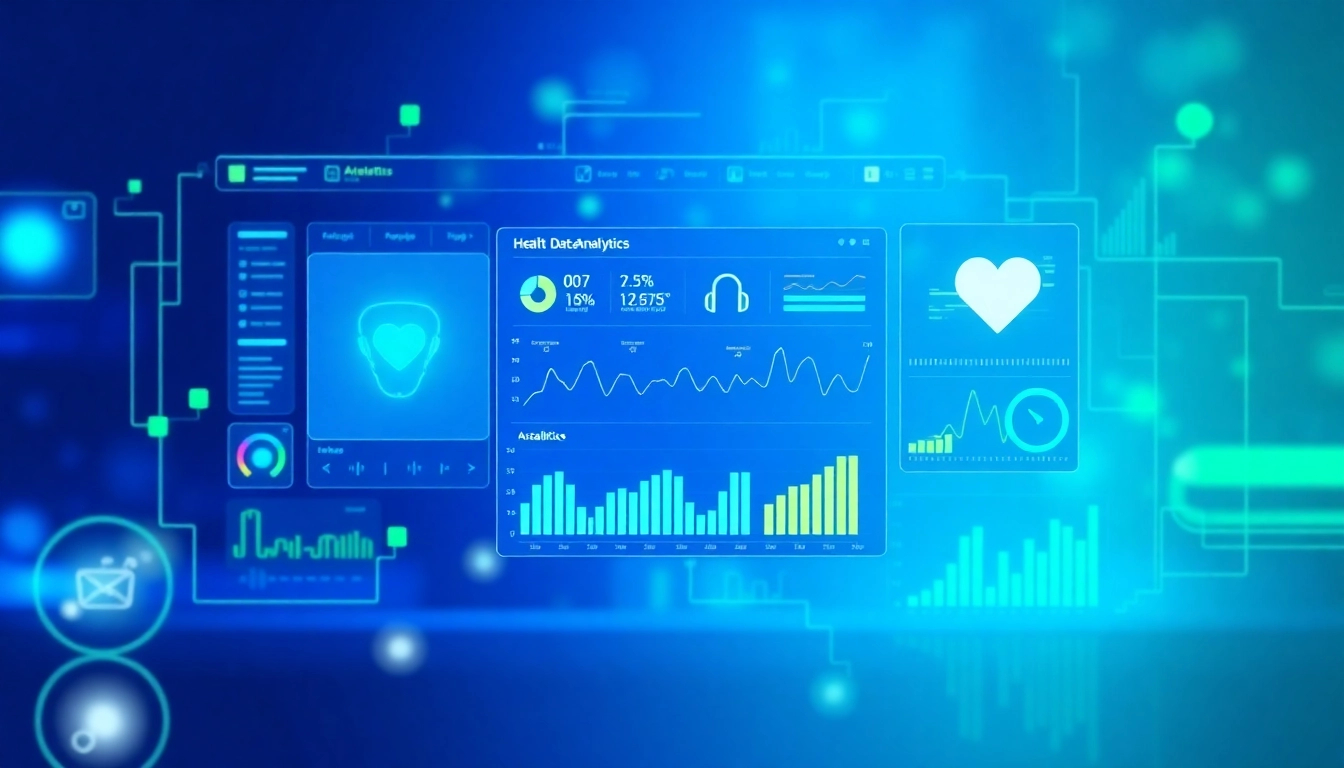Understanding Health Informatics
Health informatics is a rapidly evolving discipline at the intersection of information technology, data analysis, and healthcare management. As healthcare systems across the globe become increasingly reliant on data-driven decision-making, understanding the principles and applications of health informatics becomes paramount. By utilizing structured data, technology, and innovative methodologies, health informatics aims to improve patient care, streamline healthcare processes, and enhance overall health outcomes. For further insights into this field, visit https://www.informaticsview.com.
What is Health Informatics?
Health informatics refers to the interdisciplinary study that combines healthcare, information technology (IT), and communication. This field focuses on the design, development, implementation, and evaluation of information systems that support healthcare services. Health informatics encompasses a variety of functions, including electronic health records (EHRs), telemedicine solutions, health information exchanges (HIEs), and clinical decision support systems (CDSS).
As a critical component of modern healthcare, informatics enhances the ability of healthcare providers to access, manage, and analyze patient data, leading to informed medical decisions and improved patient outcomes. The discipline not only focuses on technology but also integrates aspects of ethics, policy, and organizational strategies, providing a holistic perspective on healthcare innovation.
The Role of Technology in Healthcare
Technology plays a pivotal role in enhancing healthcare delivery and efficiency. The implementation of electronic health records has replaced traditional paper records, significantly improving documentation accuracy and accessibility. Key technologies in health informatics include:
- Electronic Health Records (EHRs): EHRs are digital versions of patients’ paper charts that provide real-time access to patient data for authorized users. They improve the coordination of care and reduce the likelihood of errors.
- Health Information Exchange (HIE): HIEs facilitate the secure exchange of patient information among different healthcare entities, ensuring that critical health data is accessible when needed.
- Telemedicine: Telemedicine leverages technology to offer remote clinical services, improving access to healthcare and enabling timely interventions.
- Clinical Decision Support Systems (CDSS): These systems provide clinicians with data-driven insights and recommendations based on patient information and clinical guidelines, aiding in decision-making processes.
Key Terminologies in Informatics
Understanding health informatics necessitates familiarity with certain key terminologies:
- Interoperability: The ability of different information systems, devices, and applications to communicate and exchange data effectively.
- Data Analytics: The qualitative and quantitative techniques used to analyze health data to extract patterns and drive decision-making.
- Patient Engagement: Strategies and tools that encourage patients to take an active role in their healthcare processes, often mediated through digital platforms.
- Usability: Refers to how user-friendly a system is, directly impacting the effectiveness and satisfaction of end-users in healthcare settings.
Benefits of Implementing Informatics Solutions
The integration of informatics solutions into healthcare offers numerous advantages, transforming the traditional paradigms of patient care and operational efficiency.
Improving Patient Outcomes
One of the primary goals of health informatics is to enhance patient care. Effective informatics applications enable healthcare providers to deliver timely and accurate care, leading to better patient outcomes. For instance, electronic health records allow for thorough and up-to-date patient histories, which facilitate more precise diagnostics and treatment planning. This, in turn, can lower the incidences of medical errors and hospital readmissions.
Streamlining Healthcare Processes
Health informatics optimizes communication and workflow within healthcare organizations. Automated systems reduce administrative burdens, thus allowing healthcare professionals to focus more on patient care rather than paperwork. By streamlining processes, healthcare organizations can also decrease costs and improve service delivery times. Furthermore, data analytics can help identify inefficiencies, allowing organizations to implement precise changes that enhance overall operational effectiveness.
Enhancing Data Security and Privacy
As healthcare continues to digitize, data security and patient privacy remain top priorities. Health informatics solutions incorporate advanced security protocols, such as encryption and access controls, to protect sensitive patient information from unauthorized access and breaches. Compliance with regulations like HIPAA ensures that patient data is handled with the utmost confidentiality and integrity, fostering trust among patients and healthcare providers alike.
Challenges in Health Informatics
Despite the obvious advantages of implementing health informatics solutions, there are several challenges that organizations must navigate during the transition.
Integration with Existing Systems
Integrating new informatics solutions with existing healthcare systems can be a formidable challenge. Many organizations rely on legacy systems that may not communicate seamlessly with new technologies, leading to data silos and inefficient workflows. To tackle this challenge, healthcare providers should prioritize selecting interoperable systems and investing in middleware solutions that facilitate integration.
User Training and Acceptance
The successful implementation of informatics solutions also hinges on user acceptance. Healthcare staff may be resistant to change, particularly if they are accustomed to traditional workflows. Comprehensive training programs that emphasize the benefits of informatics technologies, along with ongoing support, can improve user adoption rates and ensure that staff members feel confident utilizing new tools.
Financial Constraints in Implementation
Cost considerations often pose significant barriers to adopting advanced informatics systems. Budget constraints can limit the ability of healthcare organizations to invest in necessary technologies and staff training. To overcome financial challenges, healthcare organizations could consider phased implementations, seek grant funding, or explore partnerships with technology vendors to reduce upfront costs.
Best Practices for Effective Informatics
To maximize the effectiveness of informatics solutions, healthcare organizations should adhere to several best practices throughout the implementation process.
Establishing Clear Objectives
Before embarking on any informatics initiative, it is essential to set clear, measurable objectives. These objectives should align with broader organizational goals and focus on addressing specific challenges or improving patient outcomes. Depending on the organization’s needs, objectives may range from improving patient care efficiency to enhancing data security.
Utilizing User-Centric Design
User experience is fundamental to the success of informatics solutions. Employing a user-centric design approach during the development and deployment phases helps ensure that systems are intuitive and meet the actual needs of clinicians and staff. Involving end-users in the design process can yield valuable insights that enhance functionality and usability.
Regular Performance Evaluations
Continuous improvement is vital in informatics. Organizations should regularly evaluate the performance of their systems, soliciting feedback from users and key stakeholders. By conducting performance audits, healthcare organizations can identify areas for enhancement and ensure systems are effectively contributing to healthcare goals.
Future Trends in Health Informatics
The landscape of health informatics is rapidly changing, with emerging technologies and evolving patient needs driving the direction of the field. Understanding these trends is essential for healthcare organizations aiming to remain at the forefront of healthcare innovation.
The Role of AI and Machine Learning
Artificial intelligence (AI) and machine learning (ML) are transforming how healthcare data is analyzed and utilized. These technologies can process vast amounts of data quickly, identifying patterns and predicting outcomes that enhance decision-making. AI-powered tools can assist in clinical diagnosis, improve personalized care delivery, and optimize operational efficiencies by predicting demand for services.
Personalized Medicine and Informatics
Personalized medicine is gaining traction in healthcare, allowing for tailored treatments based on patients’ genetic and phenotypic characteristics. Health informatics systems facilitate the management and analysis of genetic data, making personalized approaches feasible and effective. By leveraging big data analytics, healthcare providers can offer customized treatment plans that improve patient outcomes.
Telemedicine Integration and Growth
The COVID-19 pandemic has accelerated the adoption of telemedicine across the globe, fundamentally changing how patients and providers connect. As telemedicine continues to grow, health informatics plays a crucial role in developing secure, user-friendly platforms that enable virtual consultations, remote monitoring, and follow-up care. Future innovations in telehealth are likely to further enhance accessibility and ensure continuity of care, particularly in underserved populations.
In conclusion, health informatics represents a significant advancement in the healthcare sector, offering the potential to optimize patient care delivery and streamline operations. By understanding the necessary components of health informatics, organizations can navigate its complexities and embrace new technologies that enhance healthcare outcomes. Through effective implementation strategies, best practices, and awareness of emerging trends, healthcare providers can position themselves to meet the evolving demands of the future.



